HTPC - TV Tuner Reviews
by Jarred Walton on December 7, 2005 12:05 AM EST- Posted in
- Smartphones
- Mobile
Performance Considerations
We've talked a lot about the cards, but we haven't said much about the actual performance or CPU usage. It varies by card, as well as what content you're watching, so we captured some graphs showing CPU usage in a variety of situations. For the most part, anything faster than around 1.6 GHz P4 or 1600+ Athlon should suffice, though just to be safe, you might want closer to 2.4 GHz/2400+. Using the Sempron 64 running at 2.50 GHz was more than sufficient for everything but the MyHD analog recording. Let's start first by looking at how each card performs in analog mode. The MyHD and Theater 550 are running on the Athlon 64 4000+ HP system, while the Fusion5 is in the Sempron system. Don't worry - we're only looking for a rough estimate of CPU power requirements, and the Fusion5 worked fine with the Sempron as well as the slightly faster HP.
For watching analog content, not only is the Theater 550 a better image, but it also uses far less CPU power. In fact, the image for watching and recording with the Theater 550 is the same. Can you spot the point where we enabled recording in the graph? (The higher CPU usage at the start is actually PowerCinema loading, so don't confuse that with the latter portion of the chart.) We began recording the station on the 550 around the spot marked by the two "peaks" where CPU use spiked to 40% or so. Otherwise, CPU use remains around 10%.
The Fusion does quite well when only viewing analog channels, averaging around 20% CPU use on the Sempron system and slightly less (15%) on the 4000+ (which we didn't capture). Recording with the Fusion5 kicks CPU usage up to about 60%. That's a pretty big jump, but we were running with a maximized viewport (720p content), and we didn't experience any stalls or other problems. For watching an analog channel, the Fusion5 is a close second to the Theater 550, though it's a distant second for recording the content.
Finally, we have the MyHD card. Similar to the Fusion, watching an analog channel uses less CPU time than recording the channel. However, less in this case means about 40% CPU usage. Enabling even the fastest DivX encoding (with MP3 audio) kicks the CPU up to almost 80% usage. The video capture doesn't cut out, but there does seem to be a slight delay every second or so. Even though there is supposedly 20% idle CPU time, the capture isn't really clean, and it's about equal to watching TV with only mediocre reception. We don't have a graph, but moving to the 2.6 GHz X2 chip with Normal quality DivX encoding still used a whopping 65% of the CPU time - remember that there are two cores, so that would be over 130% CPU time for the 4000+. The faster X2 also removed the slight lag in the video, all while producing a much better encode.
Here's another version of the data, with a few additional reference points. The graphs are colored according to performance: green indicates that there were no difficulties, yellow means that there may be periodic issues, and red means that the result was unacceptable.
Moving to digital channels removes the Theater 550 from the list, but we have both the DxVA accelerated and non-DxVA modes in FusionHDTV. Most modern GPUs can use the DxVA acceleration, so consider the non-DxVA charts to be a worst case scenario. All of the results were taken while viewing a 1080i football game broadcast.
With DxVA enabled, watching 1080i with the Fusion5 requires about 20% of your CPU time. Recoding the same content appears to add about 10% more CPU use, and we get close to 30%. The non-DxVA mode requires quite a bit more power to handle the decoding of the digital signal, using 45% of the CPU power. As before, recording the same content appears to add another 10%. Remember that unlike analog signals, digital TV is already compressed. Decompressing is quite a bit easier than compressing a signal, which is why a Sempron can handle 1920x1080 video at 30 FPS without trouble, whereas the same CPU chokes when attempting to encode even 640x480 video at 30 FPS.
Viewing digital content with the MyHD is completely different from using the card in analog mode. CPU usage on the 4000+ was around 25% when viewing a 1080i signal, though disabling the overlay screen knocks that down around 15%. The record mode oddly enough has consistently lower CPU usage, at around 12 or 13%. The hardware acceleration of DTV decoding that the MyHD card provides is clearly put to good use.
Again, here's the simplified graph. All of the results are green, as there were no difficulties. Judging by the CPU usage on the Sempron for the MyHD, most of the CPU usage is used by the overlay window.
We've talked a lot about the cards, but we haven't said much about the actual performance or CPU usage. It varies by card, as well as what content you're watching, so we captured some graphs showing CPU usage in a variety of situations. For the most part, anything faster than around 1.6 GHz P4 or 1600+ Athlon should suffice, though just to be safe, you might want closer to 2.4 GHz/2400+. Using the Sempron 64 running at 2.50 GHz was more than sufficient for everything but the MyHD analog recording. Let's start first by looking at how each card performs in analog mode. The MyHD and Theater 550 are running on the Athlon 64 4000+ HP system, while the Fusion5 is in the Sempron system. Don't worry - we're only looking for a rough estimate of CPU power requirements, and the Fusion5 worked fine with the Sempron as well as the slightly faster HP.
Analog Channels (watching on left, recording on right)
| FusionHDTV | |
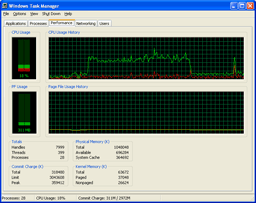 |
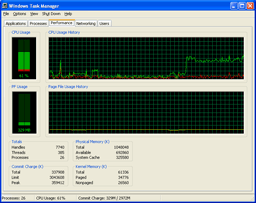 |
| Click to enlarge. | |
| MyHD | |
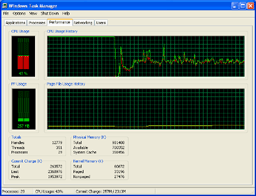
| 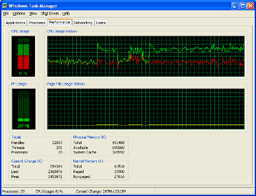 |
| Click to enlarge. | |
| Theater 550 | |
 |
 |
| Click to enlarge. | |
For watching analog content, not only is the Theater 550 a better image, but it also uses far less CPU power. In fact, the image for watching and recording with the Theater 550 is the same. Can you spot the point where we enabled recording in the graph? (The higher CPU usage at the start is actually PowerCinema loading, so don't confuse that with the latter portion of the chart.) We began recording the station on the 550 around the spot marked by the two "peaks" where CPU use spiked to 40% or so. Otherwise, CPU use remains around 10%.
The Fusion does quite well when only viewing analog channels, averaging around 20% CPU use on the Sempron system and slightly less (15%) on the 4000+ (which we didn't capture). Recording with the Fusion5 kicks CPU usage up to about 60%. That's a pretty big jump, but we were running with a maximized viewport (720p content), and we didn't experience any stalls or other problems. For watching an analog channel, the Fusion5 is a close second to the Theater 550, though it's a distant second for recording the content.
Finally, we have the MyHD card. Similar to the Fusion, watching an analog channel uses less CPU time than recording the channel. However, less in this case means about 40% CPU usage. Enabling even the fastest DivX encoding (with MP3 audio) kicks the CPU up to almost 80% usage. The video capture doesn't cut out, but there does seem to be a slight delay every second or so. Even though there is supposedly 20% idle CPU time, the capture isn't really clean, and it's about equal to watching TV with only mediocre reception. We don't have a graph, but moving to the 2.6 GHz X2 chip with Normal quality DivX encoding still used a whopping 65% of the CPU time - remember that there are two cores, so that would be over 130% CPU time for the 4000+. The faster X2 also removed the slight lag in the video, all while producing a much better encode.
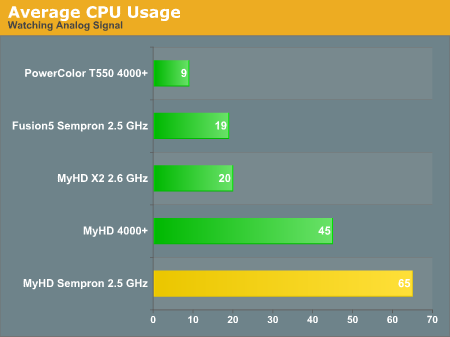
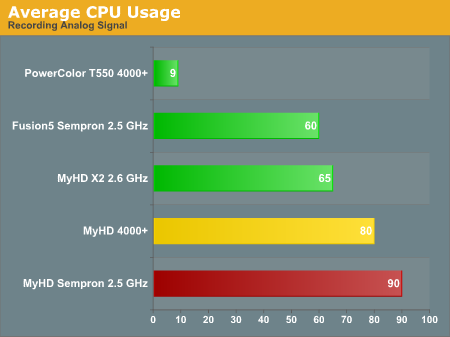
Here's another version of the data, with a few additional reference points. The graphs are colored according to performance: green indicates that there were no difficulties, yellow means that there may be periodic issues, and red means that the result was unacceptable.
Digital Channels (watching on left, recording on right)
| FusionHDTV DxVA | |
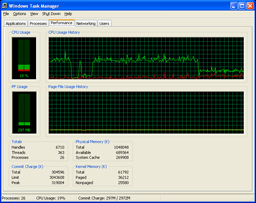 |
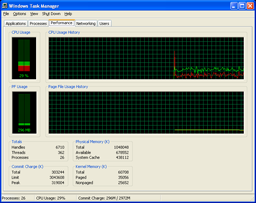 |
| Click to enlarge. | |
| FusionHDTV non-DxVA | |
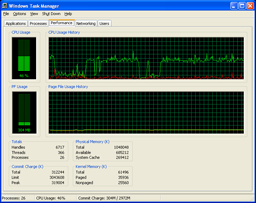 |
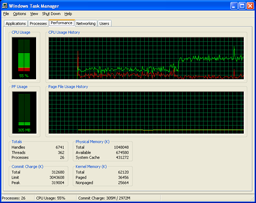 |
| Click to enlarge. | |
| MyHD | |
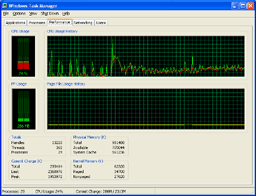 |
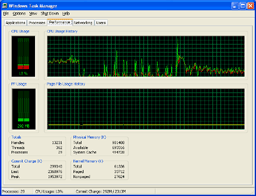 |
| Click to enlarge. | |
Moving to digital channels removes the Theater 550 from the list, but we have both the DxVA accelerated and non-DxVA modes in FusionHDTV. Most modern GPUs can use the DxVA acceleration, so consider the non-DxVA charts to be a worst case scenario. All of the results were taken while viewing a 1080i football game broadcast.
With DxVA enabled, watching 1080i with the Fusion5 requires about 20% of your CPU time. Recoding the same content appears to add about 10% more CPU use, and we get close to 30%. The non-DxVA mode requires quite a bit more power to handle the decoding of the digital signal, using 45% of the CPU power. As before, recording the same content appears to add another 10%. Remember that unlike analog signals, digital TV is already compressed. Decompressing is quite a bit easier than compressing a signal, which is why a Sempron can handle 1920x1080 video at 30 FPS without trouble, whereas the same CPU chokes when attempting to encode even 640x480 video at 30 FPS.
Viewing digital content with the MyHD is completely different from using the card in analog mode. CPU usage on the 4000+ was around 25% when viewing a 1080i signal, though disabling the overlay screen knocks that down around 15%. The record mode oddly enough has consistently lower CPU usage, at around 12 or 13%. The hardware acceleration of DTV decoding that the MyHD card provides is clearly put to good use.
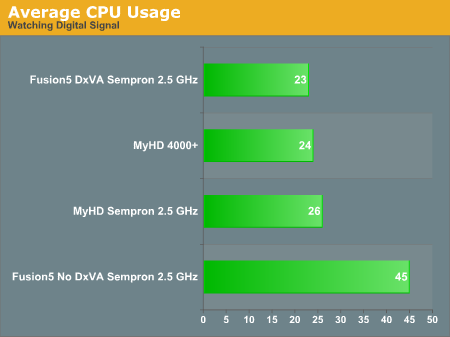
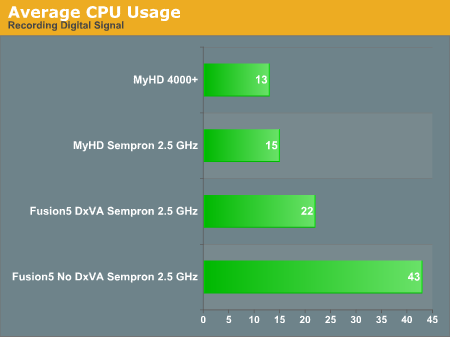
Again, here's the simplified graph. All of the results are green, as there were no difficulties. Judging by the CPU usage on the Sempron for the MyHD, most of the CPU usage is used by the overlay window.










77 Comments
View All Comments
JarredWalton - Thursday, December 8, 2005 - link
The only system it impacted was the MyHD for analog. I did perform most of the tests at stock clock speeds. But yeah, I should probably make that note. (The X2 was overclocked to 2.6 GHz as well, if you didn't notice, but I only tested the MyHD card in that system.)The Boston Dangler - Wednesday, December 7, 2005 - link
"While the Toshiba 46H84 is in fact a 1080i display - or really a 1920x540p display, if I understand it correctly"The display has 1080 horizontal lines of resolution, scanned alternately. 1080i format signals carry data roughly equivalent of 540p.
My opinion: Having owned both 1080i and 720p sets, and watching programs in their native formats, the difference in pic quality is entirely upon the display. There are both formats present in OTA/Cable, something always gets converted. Either format can provide great pics, even after conversion. It's all about the display.
"The onscreen Guide also doesn't work for me - it shows up blank - but this appears to be at least partly Comcast's fault. The FusionHDTV software is supposed to read the EPG information from the channel stream, but Comcast isn't including that in my area, as far as I can tell. (This was a problem on the MyHD as well, so that lends credence to the assumption that the local Comcast provider is to blame.)"
EPG is usually considered an extra service by content providers, thus a cable box and subscription are required. There are online alternatives, sometimes with handy plugins.
slashdotcomma - Wednesday, December 7, 2005 - link
What's the lag between signal and display? Would I be able to use any of these tuner cards and play on a gamecube,xbox(360),ps2/3, etc?JarredWalton - Wednesday, December 7, 2005 - link
I'm not quite sure what you mean. Are you trying to capture videos of your gameplay? Or just get the game console input onto your computer screen? Tuning to digital channels introduces about a two second lag, and on analog channels it's more like a .5 second to one second lag. Obviously, neither of those would be acceptable for gaming. It sounds like what you really want would be some form of transcoder?Note: it never even occurred to me to test this aspect of the cards, and I don't have a game console with which to test it. Sorry -- I'm a PC gamer. :-)
slashdotcomma - Wednesday, December 7, 2005 - link
Yes, I'm trying to get the game console input onto my computer screen. Lag for changing channels and lag between signal and screen is slightly different. For example, I played around with an AIW-9800 pro and changing channels would introduce a slight lag, but playing game consoles on it was beautiful. No lag, and everything was smooth as silk (p42.8c, 1gb ram, don't remember which MMC v9 it was). Actually it doesn't even have to be a video console, try plugging in a dvd player or vcr and try moving around in the menu. I wish more reviewers would add this to part of their reviews. I plan on playing around with Dscaler if I get the chance. There are ways to hook up game consoles to computer screen but you lose the recording ability and in some cases DVI support. Do you have a chance to play around with the older tv tuners as well?JarredWalton - Wednesday, December 7, 2005 - link
I don't have any older TV Tuners, though Anand might still have some of them. I'll have to see if I can get a game console over to try out in this fashion. I might actually have an N64 boxed up somewhere. I use PCs for DVD watching, and I don't have a VCR either, so it's going to take a bit of work. I do know that if I tune in the Comcast box to an analog channel and at least one or two of the tuners (I don't recall which), they were not in sync with each other; the Comcast was slightly ahead all the time, so it seems like lag is present.sprockkets - Wednesday, December 7, 2005 - link
I record for example LOST from the s-video out on my HDTV receiver, and it goes to a Lite On recorder on highest quality, and if you see it you would be hard pressed to tell the difference. Or, you can simply record 720x480 at a high quality via s-video in and get the same results on these cards. Of course that means setting up two devices.Does HDTV recording from these cards preserve the Dolby Digital 5.1 signal as well?
segagenesis - Wednesday, December 7, 2005 - link
Yes, they should. If you have ever checked out any of the Lost tv torrents you would be familiar that this is possible also ;)vailr - Wednesday, December 7, 2005 - link
ATI's MMC v. 9.10 may work with 550 tuner cards, according to this thread:http://www.rage3d.com/board/showthread.php?t=33835...">ATI words on MMC 9.10: Dual-tuner MulTView + 550 support!
Combined with their Gemstar GuidePlus software, would enable an electronic program guide.
Note: MMC 9.10 is not currently available on ATI's web site; only on the software CD provided with their latest XT180AIW card.
vailr - Wednesday, December 7, 2005 - link
The link is for the older PCI version, not the currently reviewed PCIe version.